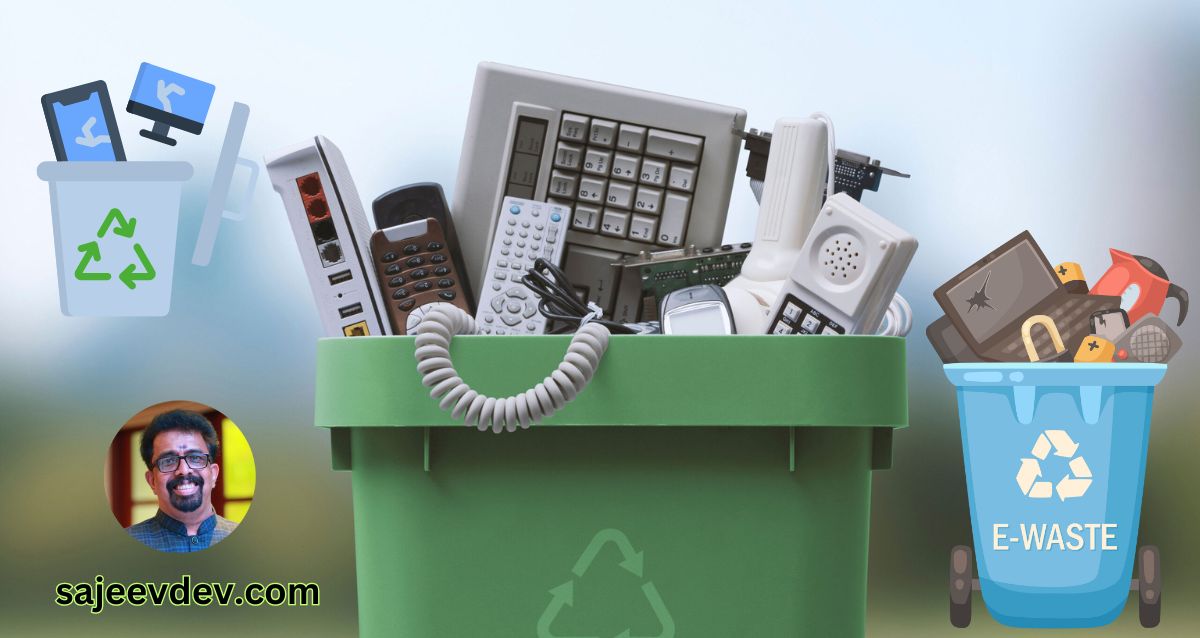Defining E-Waste: Scope and Categories
Electronic waste, commonly referred to as e-waste, encompasses a broad range of discarded electrical and electronic devices. It includes any item that relies on electricity to function, which is no longer in use or has reached the end of its life cycle. E-waste has become a growing concern globally due to its increasing volume and the risks it poses to both health and the environment. Understanding the different categories of e-waste is essential for effective management and recycling.
E-waste can be segmented into various categories based on the type of device and its function. One primary category consists of household appliances which includes items such as refrigerators, washing machines, and microwaves. These appliances often contain hazardous materials like refrigerants and heavy metals, making their proper disposal critical.
Another significant segment is IT and telecommunication equipment. This category includes computers, laptops, printers, and mobile phones. With the fast-paced advancement in technology, these devices are frequently upgraded, resulting in large amounts of discarded equipment that may contain sensitive data and toxic components.
Consumer electronics form yet another category of e-waste. This includes devices such as televisions, audio systems, and gaming consoles. The rapid innovation in consumer electronics leads to a cycle of obsolescence, creating an accumulation of outdated devices.
Furthermore, lighting devices, particularly those utilizing technology like compact fluorescent lamps (CFLs) and LED lights, also qualify as e-waste due to their electronic components. In addition to these categories, medical devices, which range from imaging machines to simple electronic thermometers, are increasingly being recognized as a crucial component of the e-waste sector.
Other miscellaneous devices like tools, toys, and wearable technology also contribute to the growing e-waste dilemma, highlighting the pervasive nature of electronic waste in our daily lives. By recognizing these categories, stakeholders can better address the challenges posed by e-waste and promote sustainable practices.
The Growing Concern of E-Waste
The rapid increase in electronic waste, commonly referred to as e-waste, has emerged as a significant global concern. This surge can primarily be attributed to the fast-paced advancements in technology that lead to shorter lifespans for consumer electronics. Devices that were once considered state-of-the-art quickly become obsolete, prompting consumers to replace them at an alarming rate. The average lifespan of many electronics has decreased dramatically, with many products becoming outdated within a couple of years. This phenomenon not only reflects the technological landscape but also speaks to the broader cultural trends, particularly the rise in consumerism. As society increasingly values the latest gadgets, the demand for new electronics escalates, further exacerbating the issue of e-waste.
Another vital factor contributing to the growing concern of e-waste is the lack of adequate disposal and recycling solutions. Many consumers are unaware of proper disposal methods for their discarded electronics, leading to improper disposal practices that can result in hazardous environmental impacts. The complexity of recycling electronic devices, due to the diverse materials and components involved, makes it challenging to manage e-waste effectively. Furthermore, in many regions, there is insufficient infrastructure to handle the collection and processing of e-waste, which compounds the problem and often leads to hazardous waste being deposited in landfills or incinerated.
According to recent statistics, the global volume of e-waste is projected to reach over 74 million metric tons by 2030, demonstrating an alarming growth trend. This statistic highlights the urgent need for increased awareness, better disposal options, and robust policies aimed at managing e-waste sustainably. The challenges posed by e-waste necessitate a concerted effort from consumers, manufacturers, and governments alike to address the growing concern and to develop comprehensive solutions for a sustainable future.
Composition of E-Waste: Valuable vs. Hazardous Materials
E-waste, or electronic waste, consists of discarded electronic devices that are no longer in use or are obsolete. Its composition is complex, comprised of various materials that can be broadly categorized into valuable and hazardous components. Understanding the makeup of e-waste is crucial for recycling efforts as well as for addressing environmental concerns associated with improper disposal.
Among the valuable materials found in e-waste are precious metals such as gold, silver, palladium, and copper. These elements are often integrated into circuit boards, connectors, and wiring due to their excellent conductivity and resistance to corrosion. Research indicates that a metric ton of circuit boards can contain as much as 40 times more gold than a gold mine. This highlights the significance of recovery techniques aimed at extracting these valuable materials through recycling processes. Efficiently reclaiming these metals not only diminishes the need for mining but also contributes to a circular economy by reintegrating them into the production of new electronic devices.
In contrast, e-waste also harbors a range of hazardous materials, including lead, mercury, cadmium, and brominated flame retardants. For instance, lead is commonly found in cathode ray tubes (CRTs) and solder joints, while mercury is used in switches and displays. When these substances are released into the environment through improper disposal or incineration, they can leach into soil and groundwater, posing significant health risks to humans and ecosystems. Prolonged exposure to hazardous materials can lead to serious health problems, including neurological disorders and various forms of cancer.
It is thus imperative to implement robust e-waste management strategies that emphasize recycling and safe disposal practices. By recognizing the dual nature of e-waste as a source of valuable resources and hazardous materials, stakeholders can work towards achieving a more sustainable future.
Environmental and Health Implications of E-Waste
The improper disposal of electronic waste (e-waste) presents significant environmental and health challenges. E-waste contains hazardous materials such as lead, mercury, cadmium, and brominated flame retardants, which can leach into the soil and water systems, effectively contaminating local ecosystems. When e-waste is improperly handled, particularly in informal recycling settings, these toxic substances can accumulate, leading to severe environmental degradation. For instance, lead exposure is notorious for its detrimental effects on brain development in children, while mercury can affect fish populations and subsequently disrupt entire aquatic food chains.
In addition to environmental concerns, the health risks posed to individuals involved in informal e-waste recycling are alarming. Workers in these sectors often lack adequate safety measures and training, making them vulnerable to hazardous exposures. Prolonged exposure to harmful substances found in e-waste can lead to various respiratory and neurological issues. For example, inhaling toxic fumes from burning circuit boards may result in chronic respiratory problems, while exposure to heavy metals can lead to cognitive impairments and neurological disorders.
The impact of hazardous waste on human health, particularly in communities engaged in informal e-waste recycling, needs to be addressed urgently. Vulnerable populations, including women and children who may be involved in these processes, require protection from exposure to these toxins. Implementing stricter regulations on e-waste disposal, promoting safe recycling practices, and raising awareness about the hazards associated with improper e-waste management are crucial steps towards mitigating these health risks and reducing environmental damage.
By prioritizing safe and responsible e-waste recycling methods, we move towards a sustainable future that minimizes the adverse effects on both the environment and public health.
E-Waste Management and Recycling Processes
Effective e-waste management plays a pivotal role in mitigating the environmental impacts associated with discarded electronic devices. The management process encompasses several crucial steps to ensure that e-waste is handled responsibly and that valuable materials are recovered while hazardous substances are safely disposed of. The first step is collection, where discarded electronics are gathered from various sources such as households, businesses, and recycling centers. Promoting community awareness about e-waste disposal options leads to higher collection rates and, consequently, a more efficient recycling process.
Following collection, the next critical phase is sorting. During this stage, different types of e-waste are categorized based on their material composition and potential for recycling. This process is essential, as proper sorting maximizes recovery rates of valuable metals and other reusable components. Once sorted, the dismantling process begins. This involves breaking down the devices into smaller parts, removing components like batteries, circuit boards, and plastics. Dismantling should be done with care as certain elements may contain toxic materials that require special handling.
After dismantling, the recycling phase takes place. In this step, recovered materials are processed utilizing various techniques such as shredding, smelting, or chemical processing. These methods enable the separation of metals, plastics, and glass, facilitating the re-entry of these materials into the production cycle. Finally, safe disposal comes into play for any hazardous substances that cannot be recycled. This phase ensures compliance with environmental regulations and protects public health. Improving efficiency in each of these stages is vital not only for reducing overall waste but also for creating a sustainable approach to managing e-waste in a way that conserves resources and protects ecosystems.
Global Challenges in E-Waste Management
The rapid advancement of technology has undoubtedly contributed to increased levels of electronic waste, commonly known as e-waste, presenting significant challenges to global management efforts. One of the most pressing issues is the illegal exportation of e-waste from developed countries to developing nations. Often, these electronic devices, which may still contain valuable materials, end up in regions with inadequate waste disposal regulations. The lack of stringent environmental laws in these countries leads to hazardous informal recycling practices, where e-waste is handled without proper safety measures, resulting in serious health risks for workers and environmental degradation.
Additionally, public awareness surrounding e-waste issues remains alarmingly low. Many consumers are not fully informed about the environmental impact of their electronic devices, leading them to dispose of their e-waste improperly. This lack of awareness exacerbates the problem, as consumers often overlook recycling options and opt for conventional trash disposal instead. Raising public consciousness about the importance of responsible e-waste management is crucial for fostering a culture of sustainability and ensuring that more individuals engage in proper disposal methods.
Legislative enforcement is another significant hurdle in effective e-waste management. While many countries have introduced laws aimed at regulating e-waste, insufficient enforcement mechanisms and a lack of resources hinder their implementation. This creates loopholes that allow illegal e-waste practices to persist. Furthermore, the disparity between various national regulations creates challenges in achieving a unified approach to e-waste management, further complicating global efforts. Addressing these challenges requires international collaboration, effective policy frameworks, and increased public education to ensure a healthier and more sustainable future for electronic device disposal.
The Role of Legislation in E-Waste Management
Legislation plays a crucial role in the management of electronic waste (e-waste), establishing guidelines and frameworks that aim to mitigate the environmental impact of discarded electronic devices. Various regulations have been adopted worldwide to address this growing concern, with notable examples being the European Union’s Waste Electrical and Electronic Equipment (WEEE) directive and India’s E-Waste Management Rules, 2016. These legislative measures underscore the urgent need for comprehensive strategies to handle e-waste and promote sustainable practices.
The WEEE directive, implemented in the EU, focuses on the collection, recycling, and recovery of e-waste. One of its central tenets is the principle of Extended Producer Responsibility (EPR), which mandates manufacturers to take accountability for the entire lifecycle of their products. This includes obligations for proper disposal, recycling, and minimizing environmental harm caused by their products. By shifting financial and environmental responsibilities onto producers, the WEEE directive aims to encourage manufacturers to design more sustainable products and reduce waste generation.
India’s E-Waste Management Rules, 2016, represent a significant step towards regulated e-waste management in a rapidly digitizing economy. Similar to the WEEE directive, these regulations emphasize EPR, requiring producers to establish take-back systems for their products. This initiative not only facilitates proper disposal and recycling but also promotes consumer awareness about e-waste and its implications on health and the environment. Furthermore, these rules are designed to provide a framework for safe collection, transportation, and storage of e-waste, fostering a circular economy.
Overall, effective legislation is instrumental in the transition towards sustainable e-waste management practices. By advancing regulations that hold manufacturers accountable and promote responsible disposal, countries can combat the e-waste crisis and foster a more sustainable future. These legal frameworks not only protect the environment but also support innovation in product design, contributing to a more sustainable production and consumption cycle.
Innovative Solutions and Best Practices for E-Waste Management
The rapid proliferation of electronic devices has led to significant challenges concerning e-waste management. However, numerous innovative solutions and best practices are emerging to address these pressing issues. One prominent approach involves the adoption of advanced recycling technologies. Innovations such as hydrometallurgical processes use environmentally friendly solvents to extract valuable metals from e-waste, thereby reducing environmental impact while maximizing resource recovery. These technologies not only streamline the recycling process but also promote a circular economy aimed at minimizing waste.
In addition to technological advancements, community programs aimed at e-waste collection have gained traction globally. Local governments and non-profits have initiated collection drives and drop-off events, encouraging residents to recycle their outdated electronic devices responsibly. For instance, these programs often provide incentives for consumers, such as discounts on future electronics purchases, thereby increasing public participation and awareness regarding the importance of e-waste recycling.
Moreover, initiatives aimed at enhancing public awareness about e-waste have proven integral in promoting responsible disposal practices. Educational campaigns conducted in schools, communities, and digital platforms inform individuals about the environmental and health risks associated with improper e-waste disposal. By fostering a culture of sustainability, these initiatives empower individuals to make informed decisions about their electronic devices, ultimately reducing the quantity of e-waste ending up in landfills.
Corporations also play a crucial role in mitigating e-waste challenges. By implementing take-back and buy-back programs, companies not only assist consumers in recycling their legacy devices but also reclaim valuable materials for future production. Collaboration between corporations, governments, and non-profit organizations is essential in developing comprehensive strategies for e-waste management, ensuring that sustainable practices are firmly integrated into the broader framework of environmental stewardship.
Towards a Sustainable Future
As we navigate through the challenges posed by electronic waste, it is evident that proper e-waste management plays a pivotal role in safeguarding both our environment and public health. The exponential growth in electronic devices, driven by technology’s rapid advancement, has led to an unprecedented increase in e-waste generation. Without effective recycling processes and stricter regulations, the adverse effects of this waste will continue to escalate, harming ecosystems and human populations alike.
Addressing the e-waste crisis requires a multi-faceted approach that emphasizes the importance of responsible recycling practices. By enhancing existing e-waste recycling systems, we can significantly reduce the amount of hazardous materials entering landfills. Moreover, promoting the use of sustainable materials in manufacturing can alleviate the overall environmental impact. Establishing stringent regulations at both local and global levels is crucial to ensure that manufacturers and consumers remain accountable for their electronic waste, thus reducing indiscriminate disposal.
Collective responsibility is indeed essential in tackling the challenges tied to e-waste. Individuals must become more aware of their responsibility towards proper disposal and recycling of electronic devices. Meanwhile, corporations have a duty to implement environmentally friendly practices in their production processes and to provide take-back programs for their products. Governments also play a key role by enacting laws that encourage sustainable practices and providing incentives for eco-friendly initiatives.
In summary, fostering a sustainable future hinges upon concerted efforts by all stakeholders involved. By prioritizing effective e-waste management strategies, enhancing public awareness, and supporting legislative measures, we can collectively mitigate the impact of electronic waste on our planet. A collaborative approach not only protects our environment but also ensures a healthier future for generations to come.








